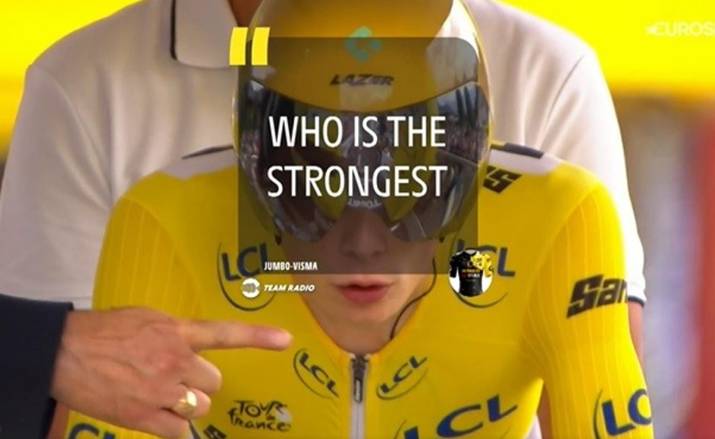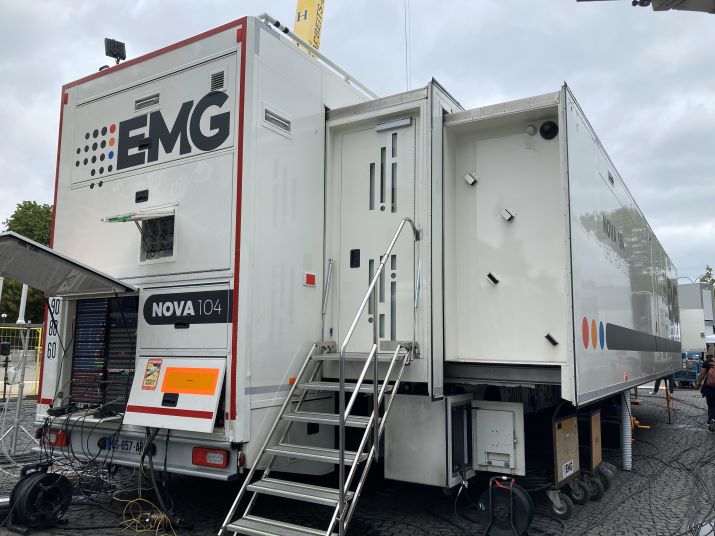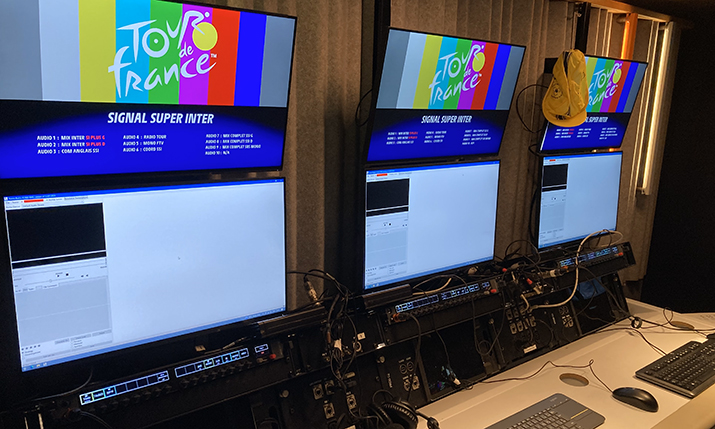Live from the Tour de France 2023: Team radio makes a resounding debut

Screenshot of a Team Radio excerpt from the 2023 Tour de France time trial
Being at the heart of the peloton and listening to the conversations between cyclists and their sports directors, Team Radio has revolutionised the way we perceive and hear the Tour de France this year with an innovation led by Amaury Sport Organisation (ASO), France Télévisions and EMG.
“I’m gone, I’m dead,” Tadej Pogacar cracks on stage 17 of the Tour de France on July 20, 2023. These words exchanged over the radio between the Slovenian cyclist and his team are broadcast almost in real time and shared with the world. They resonate as a confession of defeat against his main rival for the yellow jersey, Vingegaard. A groundbreaking moment.
In line with what has been done for several years in Formula 1, ASO has chosen to give a public dimension to the communications between sports directors and their riders in the peloton with the introduction of Team Radio to the international broadcast of the Tour de France. It is a technical and editorial advancement.
Innovation of the year
“This is the innovation of the year,” according to Guillaume Kleszcz, head of productions and broadcast Services at (ASO). The organiser of the Tour de France collaborated with the support of France Télévisions, the host broadcaster, and the EMG group to set up the technical aspects of Team Radio. After testing a beta version last year at the Tour de France Femmes, 17 out of the 22 teams in the men’s peloton trusted ASO, granting access to their previously confidential discussions.
Making the race more engaging
The goal for ASO is clear: “We want to seek a new audience,” says Kleszcz. “To do that, it’s necessary to better narrate the race, make it more understandable and interesting for viewers.”
The man is determined. The Tour de France must evolve and engage in storytelling. It is in this spirit that ASO entrusted the production of a documentary series to Netflix for the second consecutive year.
On air, viewers can hear sound excerpts transcribed in writing as well. These are generally words of encouragement, reactions, emotions, physical or mechanical issues, or observations about other riders. But the golden rule is to never betray team strategies.
Almost in real time
If viewers can listen, so can opponents, so moderation of what is broadcast is crucial. This is the work of three journalists and two moderators, all former cyclists. A selection is made with their expert perspective. It is only after a latency period of about two minutes that an excerpt can be broadcast. It is then offered to the international broadcast signal, France Télévisions, NBC, and made available for post production to rights holding channels for their pre and post-race shows.
Behind the scenes, it is the EMG teams under the Boost Graphics banner that are in charge. Based in the Nova 104 van, technicians are responsible for reception, transcription, and graphical presentation of Team Radio.

Nova 104 OB van of EMG hosts Boost Graphics, responsible for Team Radio on the 2023 Tour de France
Going beyond F1
For each cycling team, there is a radio feed that arrives at the production van. It is then automatically transcribed into text using software developed inhouse by Boost Graphics. Each journalist analyses the audio from six sports teams, based on the languages used (French, English, etc.). The journalist selects and creates audio clips, labelled with stars indicating the level of interest in the content. The moderator then chooses which clips can be broadcast.
Depending on the destination of the clip, it can be translated. For instance, a French feed might be offered in English for the international signal. Conversely, for France Télévisions, the same French clip could be sent with just audio without textual transcription on air. NBC also has a personalised Team Radio feed. A computer platform developed by Boost Graphics allows each channel to access each indexed clip.
Bruno Coudyzer, manager of Boost Graphics, enthuses: “It’s unique. Technically, we’re going beyond F1. We have a production site that spans over 150 kilometres at each stage. It’s more complex than a race circuit where everything can be cabled.”
After this initial use, ASO has already indicated its desire to enhance and develop multi-delivery for an even more personalised service to channels.
In the end, almost 1,141 Team Radio pieces of content were produced and shared with broadcasters, social networks, and cycling teams during the three weeks of the Tour de France.
Team Radio seems to have found its audience from the very first edition. The most successful Instagram post of the Tour de France is the one featuring an excerpt from the Team Radio between the Jumbo team and Vingegaard during the time trial on 16 August. The post reached four million views.

Inside the Nova 104 OB van, five stations are dedicated to the journalists and moderators of Team Radio, all former cyclists

